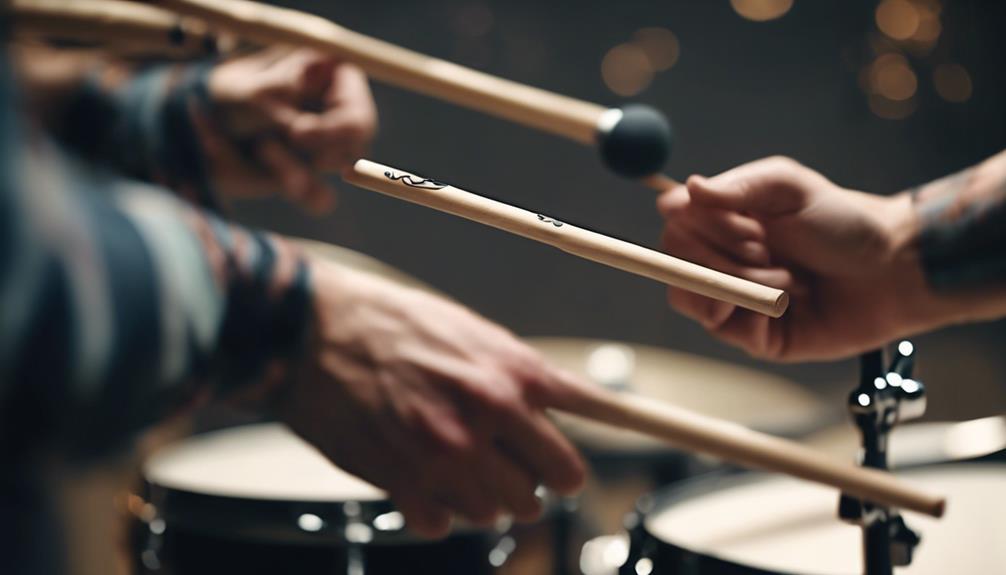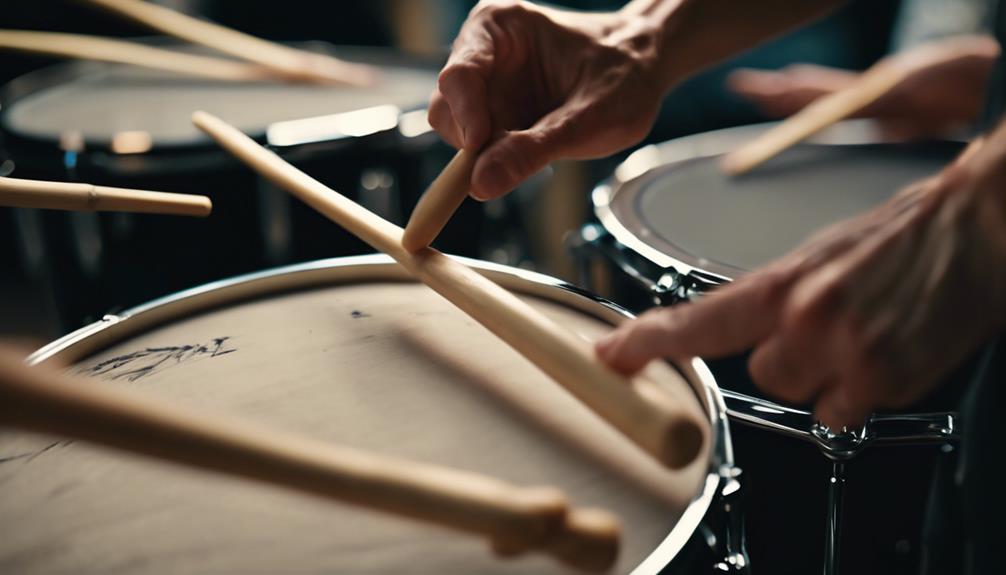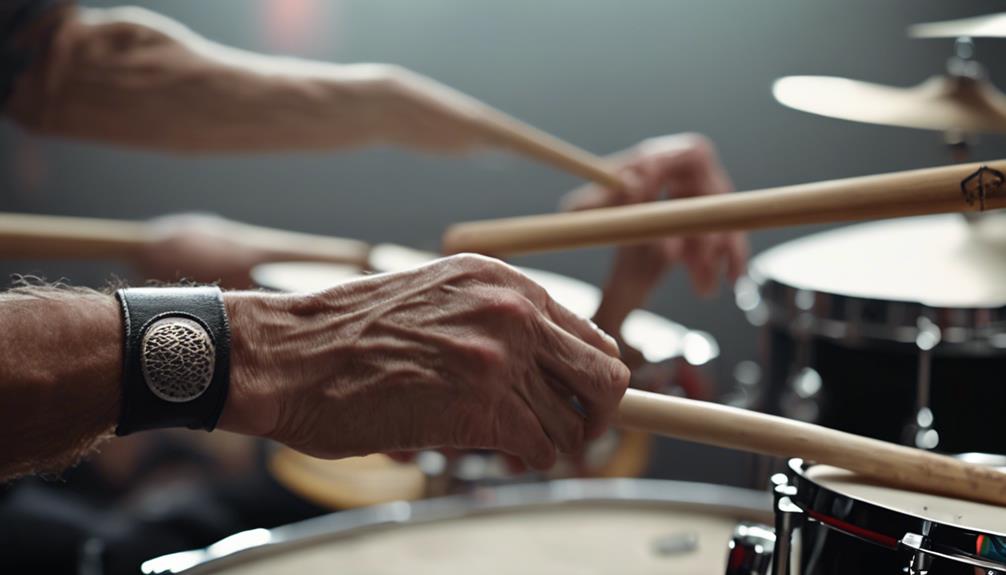When it comes to holding drum sticks, the grip you choose can have a major impact on your playing style and comfort. You might be wondering which grip—traditional, matched, French, German, or American—will work best for you. It’s important to find a balance that allows for control and precision while keeping your hands relaxed to avoid fatigue. By positioning the sticks correctly between your thumb and fingers, you can achieve a stable grip. But how do you make sure your wrist motion is just right for best control and articulation? Let’s explore the nuances of each grip technique and find out.
TL-DR
- Position the stick between your thumb and index finger at the balance point.
- Ensure your grip is relaxed to prevent hand fatigue and allow smooth movements.
- Use wrist and finger motion for control and speed, depending on the grip technique.
- Keep thumbs on top or the side of the stick for stability and balance.
- Adjust grip style (Traditional, Matched, French, German, American) based on drumming style and comfort.
Choosing the Right Grip

When selecting the appropriate grip for holding drum sticks, it’s essential to take into account the style of music you’ll be playing and your personal comfort.
Drummers use various grip techniques, each offering unique advantages. The Traditional Grip is often favored in marching bands and drum corps due to its dynamic range and articulation. This grip requires a specific hand positioning that may take some time to master but offers excellent control for intricate patterns.
Matched grip is another popular option, providing more control and versatility. With this grip, both hands hold the sticks in the same manner, allowing your weaker hand to mimic the dominant one. This symmetry is beneficial for drummers seeking balanced and consistent performance across both hands.
For more specialized techniques, you might explore the French grip, where your palms face upward and thumbs point up. This grip emphasizes finger control and speed, making it ideal for fast, intricate playing.
The German grip, conversely, has palms facing down and relies on wrist motion, perfect for slower tempos requiring great wrist control.
Lastly, the American grip combines elements of both French and German grips. It balances the use of fingers, wrist, and arm, offering a versatile up-down movement for various drumming styles.
Traditional Grip Technique
To master the traditional grip technique, you’ll need to focus on proper hand positioning, the roles of your thumb and fingers, and the motion of your wrist and arm.
Start by placing the drumstick between your thumb and index finger in your left hand, with your palm facing inward. Make sure your ring and pinky fingers are bent down, and practice rotating your wrist to strike the drum effectively.
Proper Hand Positioning
For proper hand positioning in traditional grip, hold the left drumstick with your palm facing inward and the stick resting between your thumb and index finger. Confirm that the drumstick lies comfortably in the cradle formed by your thumb and index finger, while your ring and pinky fingers are bent down, lightly touching the stick to provide additional support. Your grip should be firm yet relaxed, allowing the drumsticks to move freely in your hands without slipping.
Now, let’s focus on your right hand. In traditional grip, your right hand also faces inward, but it holds the drumstick differently. Place your thumb on top of the drumstick, with the stick running along the line between your thumb and index finger. Your fingers should wrap around the drumstick, providing a balanced grip that enables precise control and smooth execution of your drumming techniques.
Traditional grip is favored in marching bands and drum corps for its dynamic range and articulation. This grip technique allows you to execute intricate control and finesse, making it ideal for detailed and expressive performances. Practice this positioning regularly to develop a natural feel and enhance your drumming skills.
Thumb and Finger Roles
Understanding the thumb and finger roles in the traditional grip technique is essential for achieving precise control and nuanced playing. When using the traditional grip, your thumb and index finger are vital for holding the drumstick. The stick is nestled between your thumb and index finger, creating a pivot point that allows for fine-tuned movements and adjustments. This grip provides the primary source of control and stability.
Your ring finger also plays a significant role in this technique. It typically rests on top of the drumstick, offering additional support and helping to maintain balance. This placement enables you to manage the stick with greater precision, which is especially important in contexts like marching bands and drum corps, where dynamic range and articulation are critical.
To hold the stick correctly, make sure your thumb and index finger form a relaxed but firm grip. The other fingers, including the ring finger, should lightly wrap around the stick, giving you the ability to respond to different playing demands.
Wrist and Arm Motion
When mastering the traditional grip technique, focus on how your wrist and arm work together to create fluid and controlled drumming movements. Your wrist motion is vital for striking the drum accurately. In traditional grip, the wrist should move freely, allowing for precise articulation and control over each stroke. This is especially important in settings like drum corps, where dynamic range and consistency are key.
Start by positioning your arm with a slight bend at the elbow, angling it outward to facilitate smooth drumming movements. This arm motion complements the wrist action, helping you maintain control while playing. The stick should rest between your thumb and index finger, with the other fingers providing additional support and stability.
As you practice, pay close attention to how your wrist and arm coordinate. The wrist motion should initiate the strike, while the arm guides and supports the movement. This combination allows for greater articulation, enabling you to execute complex rhythms and patterns with ease.
Matched Grip Technique

Matched grip technique starts with proper hand positioning, where your palms face down and thumbs rest on top of the sticks. This grip guarantees balanced control by positioning the sticks between your ring finger, thumb, and middle finger.
Mastering finger control is essential to maintain stability and achieve consistent precision in your playing.
Proper Hand Positioning
To hold drum sticks using the matched grip technique, place your hands palms down with the sticks between your thumb, index, and middle fingers. This grip, known as the French grip, guarantees your thumbs are on top, providing better control and balance over your drum set. Keep your palms facing down and relaxed, allowing your fingers to power the movement.
A good grip is essential for achieving precision and versatility in your drumming. With matched grips, both hands mirror each other, enabling your weaker hand to mimic the dominant hand’s movements. This symmetry is advantageous in various music genres, offering consistent control and power distribution.
Make sure you hold your drumsticks firmly but not too tightly. Excessive tension can lead to fatigue and limit your mobility. The key is to maintain a balance where the sticks feel secure yet flexible enough for dynamic play. Experiment with slight adjustments to find the grip that feels most comfortable for you.
Finger Control Basics
Mastering finger control in the matched grip technique is vital for executing intricate drumming patterns with precision and ease. When you’re holding your drumsticks using the matched grip, place them between your thumb, index, and middle fingers. This grip ensures that you have improved control over the sticks, allowing you to play the drums with both power and versatility.
Finger control is essential for achieving precision in your drumming. By focusing on the movements of your fingers, you can execute complex rhythms and patterns more accurately. Maintaining a balanced grip is key; it helps prevent hand fatigue during long playing sessions, ensuring that you can keep going without compromising your performance.
Practicing finger control in the matched grip also enhances your speed and agility on the drums. The more you refine your finger movements, the quicker and more responsive your playing will become. This technique is especially beneficial for fast-paced drumming styles where quick adjustments and rapid beats are vital.
French Grip Technique
The French grip technique involves holding the drumsticks with your palms facing upward and your thumbs pointing up, allowing for greater control and finesse. This grip primarily relies on finger movements to strike the drums, letting you achieve delicate and precise drumming. It’s particularly favored in orchestral and jazz settings where nuanced and expressive performances are essential.
By keeping your palms facing upward and your thumbs pointing up, you reduce excessive wrist motion. Instead, you focus on finger agility, which enhances your ability to execute rapid and subtle strokes. This makes the French grip incredibly effective for pieces requiring speed and intricate rhythms.
To master this technique, start by gripping the sticks lightly with your fingers, allowing them to move independently. Practice controlling the sticks with minimal wrist involvement. You’ll find that this approach not only improves your speed but also your dynamic control, making your play more versatile.
Experiment with the French grip to expand your drumming capabilities. It’s a valuable skill that can transform your playing, especially in complex musical genres. By honing this grip, you’ll develop a more refined touch and greater precision in your drumming.
German Grip Technique

While the French grip excels in finesse and speed, the German grip offers a powerful alternative with its emphasis on wrist motion and strength. To use the German grip, hold your drum sticks at the balance point with your palms facing downward. This position allows for excellent control and power, making it ideal for slow tempos and precise hits.
Your elbows should bend slightly outward, providing an ergonomic stance that enhances both power and control. This grip is particularly effective in heavy rock drumming, where forceful, consistent strokes are essential. The wrist motion inherent in the German grip gives you the ability to deliver strong beats without relying heavily on arm movement, reducing fatigue and increasing endurance.
In addition to rock drumming, the German grip is favored in marching band and classical music performances. Its focus on wrist motion and control makes it suitable for the demanding requirements of these settings. Whether you’re executing powerful snare rolls or maintaining steady bass drum patterns, the German grip helps you achieve the necessary precision and strength.
American Grip Technique
To utilize the American grip technique, point your index finger forward and curl it to hold the drumstick underneath. Doing so helps you find the balance point of the drumstick between your index finger and thumb. Place your thumb on the side of the drumstick for added stability. This positioning allows for better control and finesse while you play.
Maintaining a relaxed grip is essential for the American grip technique. A relaxed grip lets your fingers, wrist, and arm movements work together seamlessly. Tightening up can lead to fatigue and decreased performance. So, keep your fingers slightly loose, allowing the drumstick to pivot naturally.
The American grip technique benefits from a combination of fingers, wrist, and arm movements. Your fingers should guide the stick, while your wrist provides the primary motion for hitting the drum. Your arm movements add power and reach, especially during more dynamic drumming sections. Coordination among these parts ensures fluid, precise playing.
Next up, learn how to drum faster in this guide.
